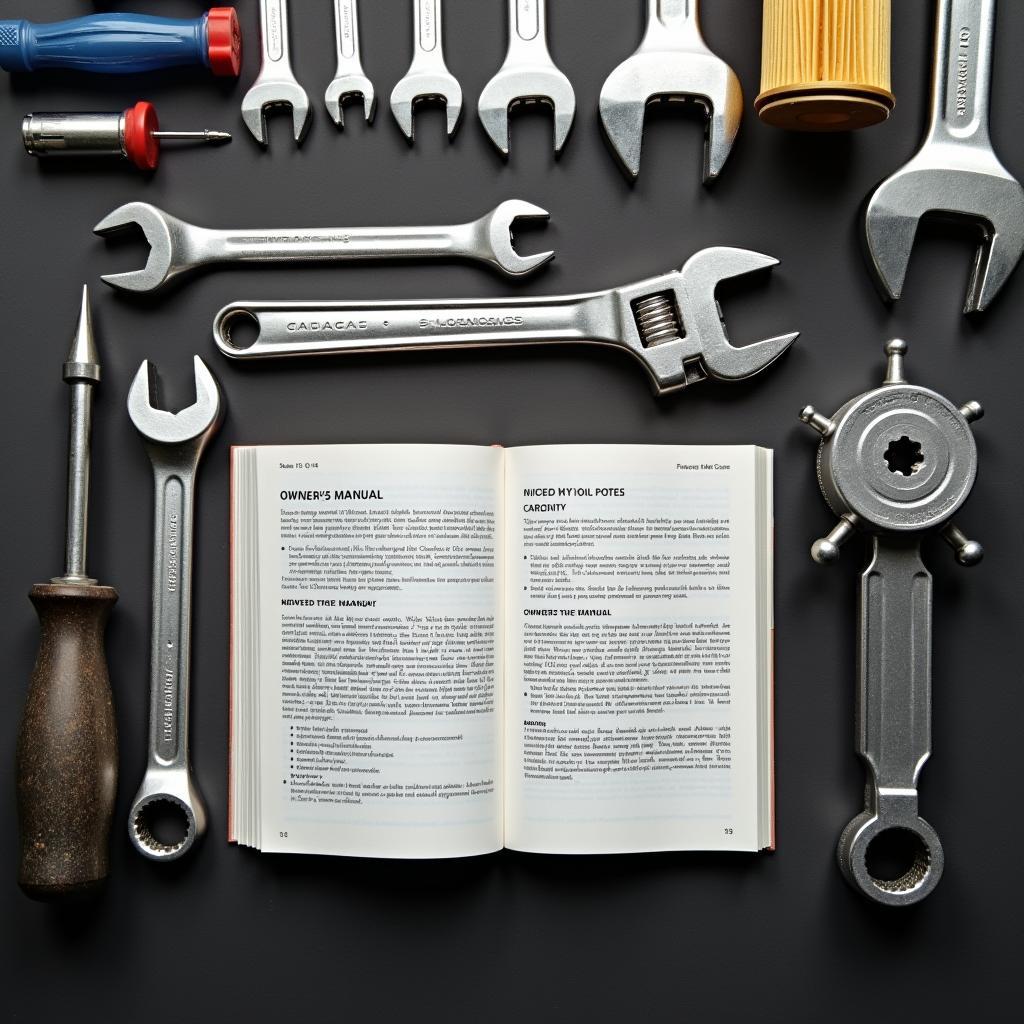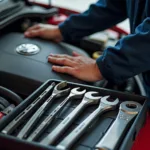Knowing how to service a car is a valuable skill, saving you money and keeping your vehicle running smoothly. This comprehensive guide provides a step-by-step approach to car servicing, even if you’re a beginner. Let’s dive in!
Understanding Car Servicing Basics
Before you begin, it’s crucial to understand what car servicing entails. Essentially, it’s a combination of checks, adjustments, and replacements performed on your vehicle at regular intervals.
What does a car service include?
A car service typically includes:
- Oil and Filter Change: This is the most common service task, crucial for engine lubrication.
- Checking Fluid Levels: This includes brake fluid, coolant, power steering fluid, and windshield washer fluid.
- Inspecting Brakes: Checking brake pads, discs, and lines for wear and tear.
- Tire Pressure and Tread Check: Ensuring tires are properly inflated and have sufficient tread depth.
- Battery Inspection: Checking battery voltage and connections.
- Air Filter Replacement: Replacing a clogged air filter improves engine performance and fuel efficiency.
Why is regular car servicing important?
Regular servicing not only keeps your car in top condition but also:
- Improves Safety: Regular checks ensure brakes, tires, and other safety-critical components are in good working order.
- Enhances Performance: Clean filters, fresh fluids, and properly functioning parts optimize engine performance and fuel efficiency.
- Extends Vehicle Lifespan: Regular maintenance prevents premature wear and tear, prolonging your car’s lifespan.
- Maintains Value: A well-maintained car holds its value better if you decide to sell or trade it in.
How to Service a Car: A Step-by-Step Guide
Now, let’s get into the nitty-gritty of how to service a car yourself. Remember, safety comes first, so always work in a well-ventilated area and wear appropriate safety gear.
1. Gather Your Tools and Materials
Before you start, ensure you have the necessary tools and materials:
- Wrenches and Sockets (various sizes)
- Screwdrivers (Phillips and flathead)
- Oil Filter Wrench
- Drain Pan
- Funnel
- New Oil
- New Oil Filter
- Shop Rags
- Gloves
- Safety Glasses
- Jack and Jack Stands (if necessary)
2. Consult Your Owner’s Manual
Your car’s owner’s manual is your best friend. It contains specific information on service intervals, recommended fluids, and other essential details tailored to your vehicle.
3. Prepare Your Workspace
Park your car on a level surface and engage the parking brake. If you’re working with the engine elevated, use jack stands for safety.
4. Changing the Engine Oil and Filter
- Locate the Oil Drain Plug: Consult your owner’s manual for its location, usually on the underside of the engine.
- Place the Drain Pan: Position the drain pan under the oil drain plug.
- Loosen and Remove the Drain Plug: Using a wrench, carefully loosen and remove the drain plug, allowing the oil to flow into the pan.
- Remove the Oil Filter: While the oil is draining, locate the oil filter (refer to your manual) and use the oil filter wrench to remove it.
- Install the New Oil Filter: Lightly lubricate the gasket of the new oil filter and screw it on hand-tight.
- Replace the Drain Plug: Once the oil is completely drained, reinstall the drain plug with a new washer if necessary.
- Add New Oil: Locate the oil filler cap (usually marked) and pour in the recommended amount and type of oil (check your manual).
- Check Oil Level: Start the engine briefly, then turn it off and wait a few minutes for the oil to settle. Check the dipstick to ensure the oil level is between the minimum and maximum marks.
5. Checking and Topping Up Fluids
- Coolant: Locate the coolant reservoir and check the level. Top up if necessary, using the correct coolant type.
- Brake Fluid: Find the brake fluid reservoir (usually near the firewall) and check the level. Add brake fluid if needed.
- Power Steering Fluid: Identify the power steering fluid reservoir and check the level. Top up as required.
- Windshield Washer Fluid: Locate the windshield washer fluid reservoir and fill it with washer fluid.
6. Inspecting Brakes
- Check Brake Pads: If possible, visually inspect the brake pads through the wheel spokes. If they appear thin or worn, it’s time for a replacement.
- Examine Brake Discs: Look for any deep grooves or scoring on the brake discs.
- Inspect Brake Lines: Check brake lines for any signs of leaks, cracks, or damage.
7. Tire Pressure and Tread Check
- Check Tire Pressure: Use a tire pressure gauge to check the pressure in each tire, including the spare. Inflate or deflate tires to the recommended pressure (found in your owner’s manual or on a sticker inside the driver’s side door jamb).
- Inspect Tire Tread: Examine the tread depth using a tread depth gauge or the penny test. If the tread is worn down, consider replacing the tires.
8. Battery Inspection
- Check Battery Terminals: Inspect battery terminals for corrosion. Clean them with a wire brush and battery terminal cleaner if necessary.
- Check Battery Voltage: If you have a multimeter, check the battery voltage. A fully charged battery should read around 12.6 volts.
9. Air Filter Replacement
- Locate the Air Filter Housing: Consult your owner’s manual for its location.
- Open the Housing: Release the clips or loosen the screws holding the air filter housing cover.
- Remove the Old Air Filter: Take out the old air filter.
- Insert the New Air Filter: Place the new air filter in the housing, ensuring it’s correctly positioned.
- Close the Housing: Secure the housing cover.
Conclusion
Performing regular car servicing is essential for maintaining your vehicle’s safety, performance, and longevity. By following these step-by-step instructions, you can gain the satisfaction of servicing your car yourself while saving money. However, remember that if you’re uncomfortable with any aspect of car maintenance, it’s always best to consult a qualified mechanic.
FAQs
1. How often should I service my car?
It depends on your vehicle’s make, model, and age. Refer to your owner’s manual for recommended service intervals. As a general rule, aim for an oil change every 3,000 miles or 3 months, whichever comes first.
2. Can I service my car myself without voiding the warranty?
Yes, you can perform basic car servicing yourself without voiding the warranty. However, keep detailed records of the maintenance you perform, including dates, parts used, and receipts.
3. What are some signs my car needs servicing?
Common signs include:
- Unusual noises coming from the engine or other components
- Warning lights illuminated on the dashboard
- Vibrations or shaking while driving
- Fluid leaks under the car
Need Help? Get in Touch!
For expert assistance with car diagnostics and troubleshooting, contact our team at CarServiceRemote!
WhatsApp: +1(641)206-8880
Email: [email protected]
Our dedicated customer support team is available 24/7 to answer your questions and provide guidance.


